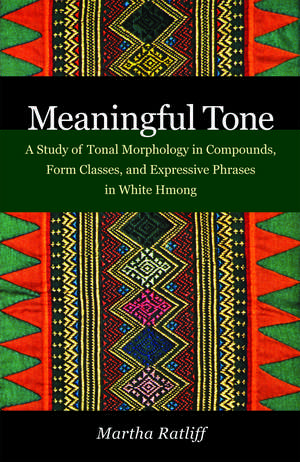Meaningful Tone: A Study of Tonal Morphology in Compounds, Form Classes, and Expressive Phrases in White Hmong
Autor Martha Ratliffen Limba Engleză Paperback – 29 apr 2010
Following U.S. military involvement in Indo-China in 1975, many of the Hmong—an ethnic group originating in Southwestern China and Southeast Asia who were persecuted by the communist organization Pathet Lao—became refugees. A large portion of them originally resettled in the Upper-Midwestern United States, but the largest population of Hmong is now in Minnesota and California. Today, there are diasporic communities in countries around the world, with over 200,000 in the United States alone. The commitment of these communities to their language and culture, their accessibility, and outside interest has combined to create an explosion of scholarship and Hmong language literature. The interest in and utility of the Hmong language are perpetually renewed by growing Hmong enrollment in schools and the number and strength of Hmong community groups. The migration and growth of Hmong and other Southeast Asian groups worldwide make this landmark language study crucial for ongoing research.
In this pioneering and innovative morpho-phonological study, Ratliff, building on the 1965 and 1967 works of E. J. A. Henderson, describes the morphological functions of tone in Southeast Asian languages. While focusing specifically on the White Hmong language, one of the languages of the larger Hmong-Mien language family, the book investigates underlying ideas about the function of tone as an organizational tool in what Ratliff calls “small word” languages. She focuses on tone and its role in compounds, form classes, and expressives.
In this pioneering and innovative morpho-phonological study, Ratliff, building on the 1965 and 1967 works of E. J. A. Henderson, describes the morphological functions of tone in Southeast Asian languages. While focusing specifically on the White Hmong language, one of the languages of the larger Hmong-Mien language family, the book investigates underlying ideas about the function of tone as an organizational tool in what Ratliff calls “small word” languages. She focuses on tone and its role in compounds, form classes, and expressives.
Preț: 157.15 lei
Nou
Puncte Express: 236
Preț estimativ în valută:
30.08€ • 32.68$ • 25.28£
30.08€ • 32.68$ • 25.28£
Carte disponibilă
Livrare economică 31 martie-14 aprilie
Preluare comenzi: 021 569.72.76
Specificații
ISBN-13: 9780875806365
ISBN-10: 0875806368
Pagini: 288
Dimensiuni: 152 x 229 x 20 mm
Greutate: 0.43 kg
Ediția:1
Editura: Northern Illinois University Press
Colecția Northern Illinois University Press
ISBN-10: 0875806368
Pagini: 288
Dimensiuni: 152 x 229 x 20 mm
Greutate: 0.43 kg
Ediția:1
Editura: Northern Illinois University Press
Colecția Northern Illinois University Press
Notă biografică
Martha Ratliff is co-founder of the Southeast Asian Linguistics Society and former chair of the Linguistic Society of America's Committee on Endangered Languages and their Preservation. She is a professor of linguistics in the English department at Wayne State University in Detroit, where she continues her research on the Hmong language, tone, and linguistics.
Descriere
Following U.S. military involvement in Indo-China in 1975, many of the Hmong—an ethnic group originating in Southwestern China and Southeast Asia who were persecuted by the communist organization Pathet Lao—became refugees. A large portion of them originally resettled in the Upper-Midwestern United States, but the largest population of Hmong is now in Minnesota and California. Today, there are diasporic communities in countries around the world, with over 200,000 in the United States alone. The commitment of these communities to their language and culture, their accessibility, and outside interest has combined to create an explosion of scholarship and Hmong language literature. The interest in and utility of the Hmong language are perpetually renewed by growing Hmong enrollment in schools and the number and strength of Hmong community groups. The migration and growth of Hmong and other Southeast Asian groups worldwide make this landmark language study crucial for ongoing research.
In this pioneering and innovative morpho-phonological study, Ratliff, building on the 1965 and 1967 works of E. J. A. Henderson, describes the morphological functions of tone in Southeast Asian languages. While focusing specifically on the White Hmong language, one of the languages of the larger Hmong-Mien language family, the book investigates underlying ideas about the function of tone as an organizational tool in what Ratliff calls “small word” languages. She focuses on tone and its role in compounds, form classes, and expressives.
In this pioneering and innovative morpho-phonological study, Ratliff, building on the 1965 and 1967 works of E. J. A. Henderson, describes the morphological functions of tone in Southeast Asian languages. While focusing specifically on the White Hmong language, one of the languages of the larger Hmong-Mien language family, the book investigates underlying ideas about the function of tone as an organizational tool in what Ratliff calls “small word” languages. She focuses on tone and its role in compounds, form classes, and expressives.



